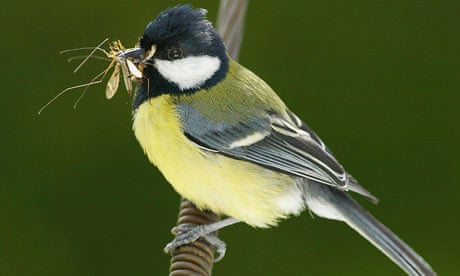These resident birds number about 3 million in the UK. Like their smaller blue cousins, they are very acrobatic, hopping from branch to branch and putting on an entertaining dance at the bird table and feeder.
The great tit has a glossy black head with white cheeks, a green back, a yellow underbelly with a black stripe and blue striped wings. It is the largest of the UK's tits, and about the same size as a house sparrow. The male is a bolder colour than the female, but even the youngest juveniles have some of the same colouring as the adults.
When not being treated at the bird table, great tits mainly eat insects, and are particularly fond of caterpillars. Researchers have recently found that the great tit is one bird that is coping well with climate change: laying their eggs earlier in the year to keep in step with the earlier emergence of caterpillars caused by warmer conditions. The study in Oxfordshire found that great tits are now laying eggs about two weeks earlier than they were in the middle of last century.
Where they live
Like the blue tit, the great tit favours woodland, parks and gardens, and nests in trees or walls. Great tits also often use nestboxes and will stay close to their nest during breeding season (spring to late summer), hissing at anything, or anyone, who gets too close.
How to spot them
Great tits are regular garden visitors, and will be attracted by seeds and nuts put out in feeders or on tables. They often flock together with blue tits, so if you see a blue tit, keep your eyes peeled for a great tit as well. Great tits are easily seen everywhere in the UK apart from the furthermost northern isles.
Listen out for
The great tit has a distinctive two-syllable song reminiscent of a fast bicycle pump.
Did you know?
The great tit has had its 15 minutes of fame: the first movement of Austrian composer Anton Bruckner's fourth symphony is made up of a series of great tit calls.
Spotter's ratings:
★★★★★ I don't believe it!
★★★★ Yabba dabba do!
★★★ Respec'!
★★ Nice to see you, to see you ...
★ Am I bovvered?
